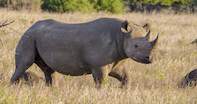
A founder population of 90 animals was introduced in the park between the 1970s and 1990 as part of a donation from the then Natal Parks Board. The focus areas for these introductions were around Skukuza and Tshokwane. Since then the black rhinos have only been counted as part of other census operations, such as the annual elephant census, but no detailed census of black rhino has been done before.
In a project funded by the WWF (World Wide Fund for Nature) and the International Rhino Foundation, a specialised team has been flying in the southern section of the park to see how many rhino they could spot.
Rhino specialists Raoul du Toit and Charles Mackey brought their Piper Super Cub and Christen Husky light aircraft from Zimbabwe and worked together with Tshokwane section ranger Steven Whitfield in the Sanparks Bantam ultralight aircraft. "We did this count as we are prioritising the monitoring of these endangered species in the park," said Judith Kruger from Sanparks Scientific Services savanna unit in Skukuza, who is leading this valuable project.
In a technique called stratified block counting, the southern section of the park was divided into 3km x 3km blocks using computer software. From these, 120 counting blocks were randomly selected which were anticipated to have either high or low rhino density.
These high and low density blocks are determined by the vegetation growing in the area and information collected from rangers and cybertracker on black rhino sightings.
The counting team consists of the pilot and a trained observer. The aircraft flies low over the tree tops of the selected block, first flying slowly over the block in strips, making a note of every rhino (black and white) that they see.
Then they fly over the densely vegetated areas in the block, carefully checking they haven't missed a black rhino concealed in the bush. "Black rhino are hard to spot in the thickets, as they are often just standing still in between the dense bushes and they don’t often stand in the open," said Judith.
So far the team has spotted 55 black rhino in the 120 blocks they surveyed and over 600 white rhinos. "It takes about 45 minutes to an hour to fly one block, depending on how dense the vegetation is", explained Judith. This stratified block counting technique has also been successfully used for black rhino in the Luangwa valley in Zambia and the Etosha National Park in Namibia.
"We are hoping to continue with a second count in October 2008 and, funds permitting, we would like to fly the survey again every two to three years" said Judith.
By Michele Hofmeyr

 Bulls weigh up to 1 200 Kg and cows about 800 Kg. As such this species is smaller than the White Rhino. It can further be distinguished from...
Bulls weigh up to 1 200 Kg and cows about 800 Kg. As such this species is smaller than the White Rhino. It can further be distinguished from...